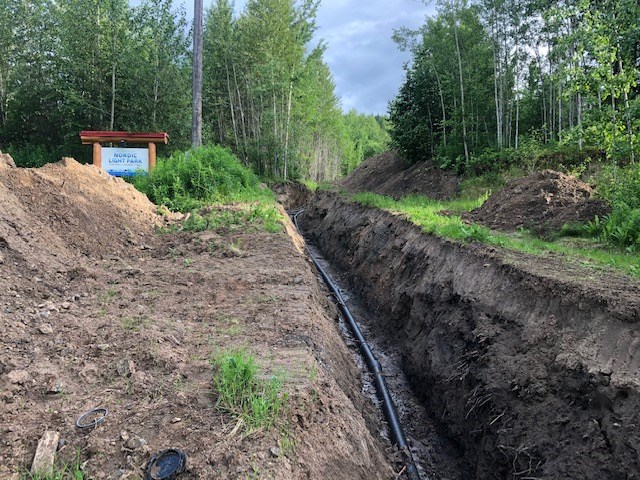Winter is coming, but not soon enough for some skiers.
For the nordic crowd at Otway Nordic Centre, November usually brings cold weather but often there’s not enough snow for skiing. This year, thanks to expanded snowmaking capabilities at the home of the Caledonia Nordic Ski Club, as long as the mercury dips well below freezing, early-season snow is a virtual guarantee.
Over the summer, a $275,000 project was completed to install 13 new hydrants to the existing five-hydrant snowmaking system built last year. The expansion will result in the coverage of about four kilometres of trails with artificially-produced snow. If Mother Nature doesn’t do the job, Caledonia trails manager Mike Palangio and the rest of the crew at Otway will be ready to fire up the snow guns.
The project was paid for by a $150,000 legacy fund left in the wake of the 2019 World Para Nordic Championships the Caledonia club hosted, as well as a $125,000 grant from Northern Development Initiative Trust. Brandt Tractors and PRD Construction also donated time, labour and equipment to dig the trenches and install the water pipes and hydrants.
“It’s kind of an ongoing legacy from the world championships and it results in leveraging more funds for the infrastructure in our community that will help members and the public for using the facility and it will also help us attract bigger events,” said Kevin Pettersen, the club’s chief of competition.
Last year’s initial phase of snowmaking created the well for the water supply and was limited to five hydrants the stadium area and biathlon range, two of the most troublesome spots in the past due to their exposure to sun which caused spring flooding and melted the access points to most of the trails.
While skiers waited for the trails to be covered in late fall, the snow machines were working overtime to create a metre-thick layer of snow in the stadium/biathlon range and some of the adjacent sprint trails, which allowed early use for skiers and extended the spring season. There was a surge of users in March when the pandemic hit and while other nordic facilities were closed Otway continued to operate until late April.
“Snowmaking made a big difference in that prolonged season because the stadium was always our weak point were the snow melt first and the benefit was even more than I expected,” said Pettersen.
The 13 new hydrants and additional 1.4 kilometres of water pipe installed this summer now connect to part of the race maze trails cleared six years ago. The expanded snowmaking capabilities also reach to the gravel pit west of the Rotary Lodge.
“That includes about a three-kilometre loop we can make on the race trails and another kilometre out to the terrain park where the gravel pit area is,” said Pettersen. “Now, if we have no other snow available we can actually run competitions based on this system.”
From each hydrant the snow guns can cover a 300-metre section of trail. The pipe, hydrants and electrical cables have all been installed and the ditches have been filled back in, all that’s left is to do is to connect the electrical lines to the pedestals.
It’s possible to make snow when the temperature falls into the 0 C - 5 C range but Pettersen says snow made at those temperatures is wet and difficult for heavy equipment operators to move around the trails. Snowmaking is much more productive and produces lighter, more crystalized snow when the air temperature drops to at least -10 C.
“The difference between making snow at minus-four and minus-10 is you get about three times the volume of the snow for the same amount of water,” he said.
To build on Otway’s growing reputation as a world-class facility, spurred by improvements to the trails and biathlon range needed for the 2015 Canada Winter Games, snowmaking became a necessity. Pettersen was in Finstrau, Germany coming back from the 2018 World Para Nordic Championships when he got the news the Canadian biathlon championships planned for Prince George that year had to be moved to an alternate venue in Canmore due to a lack of snow on the Otway trails.
“That was the decision point and snowmaking was no longer an option here, we needed to get it,” he said.
Last year, club membership swelled to 1,776 members, second only to Sovereign Lakes near Vernon as the largest Nordic ski club in Canada and North America. Caledonia added nearly 300 members last year and won a province-wide competition as the fastest-growing club. Pettersen hopes the new snowmaking capabilities will take away the early-season reluctance for people to join as season members and the club can regain its status as the largest in the country.
He applied to the BC Gaming Commission for additional funding to help pay for the next phase of expansion which would include another water well, another booster pump, an upgrade of the electrical supply from 400 amps to 600 amps and two additional snow guns. The 18-hydrant system would then be capable of running nine guns simultaneously. Without the upgrade, the system is limited to running just three guns at a time.
“Before we put in more pipe and infrastructure we need to get our water capacity up,” said Pettersen.
The Caledonia club has been selected to host the Canadian world youth/junior biathlon trials at Otway, Dec. 29-Jan. 3.

.png;w=120;h=80;mode=crop)

